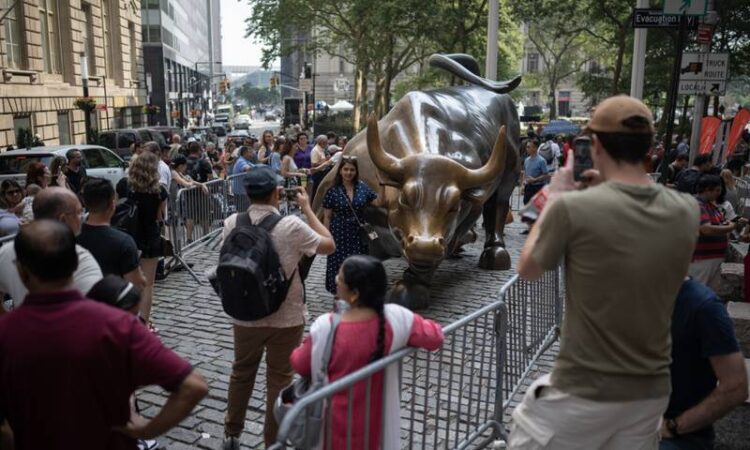
A US stocks rally is cruising into a month that has proven strong in recent years, though equities must navigate employment data and an earnings season that could be precarious, with the Federal Reserve bent on raising US interest rates.
The S&P 500 defied recession fears and a US banking crisis to notch a 15.9 per cent gain in the first half. The Nasdaq Composite powered ahead 31.7 per cent for its biggest first-half increase in four decades.
Investors betting the upward trend will continue over the next few weeks have recent history on their side. The S&P 500 has posted a positive return in eight consecutive Julys, and the tech-heavy Nasdaq 100 index has climbed in July for 15 straight years.
“We have had a pretty resilient market in the first half of this year,” said Mona Mahajan, senior investment strategist at Edward Jones.
“The market needs one big question answered, and that is what does the economy look like in the back half of the year.”
Several indicators show growing optimism about equities. Positive sentiment in the American Association of Individual Investors survey has come in above its historical average for four straight weeks, while positioning measures tracked by banks have shown investors recently increasing their exposure to stocks.
The Cboe Volatility Index, which measures investor demand for protection against stock swings, recently hit its lowest level since early 2020.
At the same time, July brings its share of potentially market-moving events. First up is next Friday’s US employment report, which will give investors a snapshot of how the economy is faring after 500 basis points of rate hikes from the Fed since last year, its most aggressive tightening in decades.
Signs of continued solid job growth could reinforce a view that has helped boost markets this year – that the US economy can avoid a severe recession despite the Fed’s tightening.
“The labour market is probably going to end up proving to be the big catalyst for what may happen market-wise and also monetary policy wise,” said Omar Aguilar, chief executive and chief investment officer of Schwab Asset Management.
Second-quarter corporate results will kick off the following week. S&P 500 companies are expected to post an overall drop in earnings of 5.7 per cent from the year-earlier period, according to Refinitiv.
Investors will focus on results from seven tech and other megacap companies, including Apple, Microsoft and Nvidia, whose outsized gains have driven the S&P 500’s rise this year.
“To the degree the Magnificent Seven has been carrying this, those are the multiples most likely to get hit with any sort of warning, any sort of negative announcement,” said John Lynch, chief investment officer of Comerica Wealth Management.
The consumer price index report arrives on July 12, a crucial read on inflation before the Fed’s July 26 policy decision. The US central bank held rates steady in June and has signalled two more increases are coming this year, including one widely expected in July.
While stocks have so far taken policymakers’ projections of higher rates in stride, that could change if bond yields continue to rise. Benchmark yields recently hit three-month highs, with the 10-year US Treasury yield last around 3.8 per cent, well over double where it stood at the end of 2021.
The labour market is probably going to end up proving to be the big catalyst for what may happen market-wise and also monetary policy wise
Omar Aguilar, chief executive and chief investment officer of Schwab Asset Management
Rising yields generally dull the allure of stocks compared to bonds, but in recent months equity valuations have still climbed.
The S&P 500 is trading at 19.1 times forward earnings estimates, well above its historic average price-to-earnings ratio of 15.6 times, according to Refinitiv Datastream.
“At some point, this move in interest rates has got to have some consequences for the markets,” Matt Maley, chief market strategist at Miller Tabak, said in a note on Friday.
Some doubt the rally’s staying power. A Deutsche Bank survey found more than three-quarters of investors believe the next 10 per cent move in the S&P 500 will be down, compared to 24 per cent who projected that in March.
Those doubts could stem from concern about economic fallout from rate hikes.
Analysts at UBS Global Wealth Management said in a recent note the likelihood of a recession hinges most on monetary policy becoming more restrictive, an eventuality stocks are not priced for.
“With stocks already priced for the near perfection of a soft landing, we see better risk-reward in high-quality bonds over equities,” the UBS analysts wrote.
Updated: July 02, 2023, 3:30 AM






